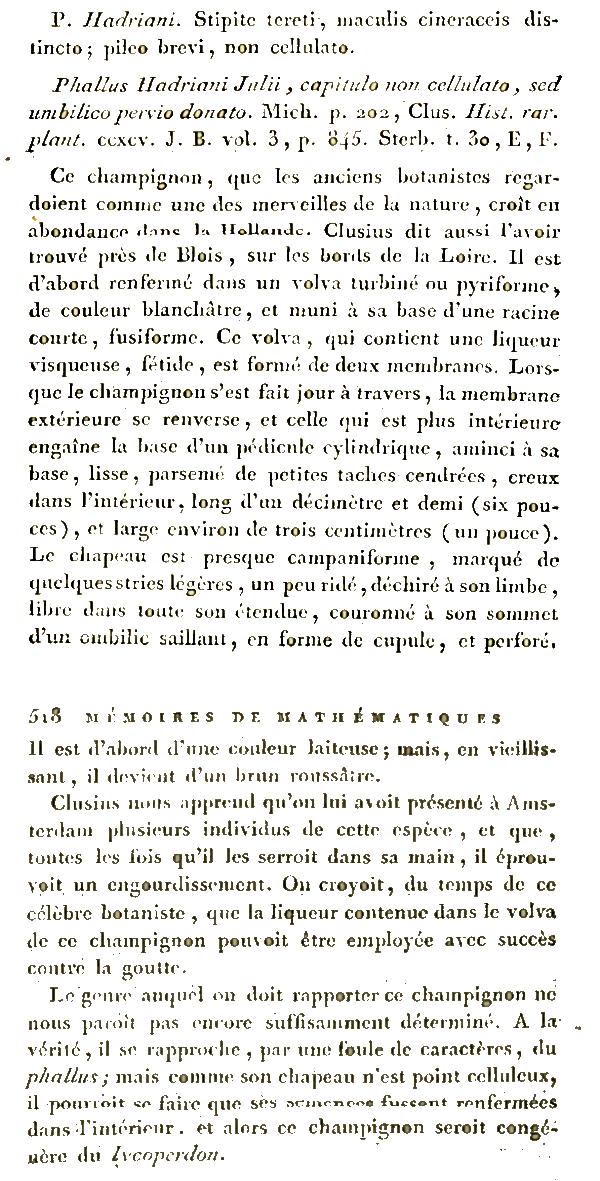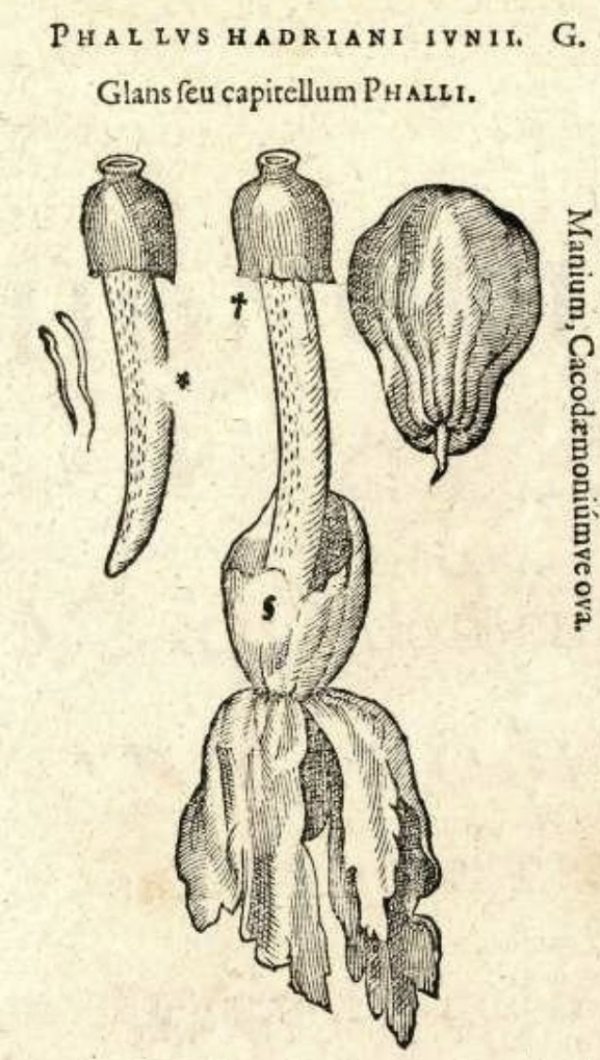
|
Phallus hadriani by Michael Kuo The name Phallus hadriani has been (and is still) applied in various ways, not all of which are compatible. In North America the name is often used to describe a Phallus impudicus-like "species" with a pink to purple, rather than white, volva and egg. However, in Europe, the name is currently applied to a coastal, dune-inhabiting species with a pink volva and larger spores than Phallus impudicus (see for example Læssøe & Petersen 2019). Descriptions from Asia and Africa (see e.g. Dring & Rayner 1967, Moreno et al. 2013) also differ. In cases like this it is often informative to consult the protologue for guidance—but in this case, one is quickly led to the conclusion that none of the contemporary applications of the name Phallus hadriani is accurate. The protologue comes from E. P. Ventenat (1798), and the text emphasizes a non-reticulated cap and a stem "distinctly spotted with gray." Since all contemporary concepts for Phallus hadriani involve a reticulated head, they are in direct conflict with the protologue. The Phallus described by Ventenat is a better match for something like Phallus campanulatus (see Trierveiler-Pereira et al. 2016), or Phallus ravenelii—and in fact the latter species is where one arrives when applying modern keys (e.g. Calonge et al. 2005) to Ventenat's description. Did Phallus ravenelii, or something like it, once occur in Europe? Or: Is is possible that the protologue for Phallus hadriani, along with the previous descriptions cited by the protologue, represent young specimens of Phallus impudicus in which the thick coating of gleba obscures the reticulation on the cap? This seems unlikely, since Ventenat emphasizes the non-reticulated cap several times, and since the Phallus hadriani description is immediately followed by a description of Phallus impudicus that emphasizes the reticulated cap. Additionally, Ventenat cites Clusius (1601), who described and illustrated the species—and while Clusius was apparently convinced that the fungus numbed his fingers, he did provide a fairly good illustration (see below) clearly depicting a non-reticulated head. My translation of Ventenat's 1798 protologue, followed by the original text and Clusius's 1601 illustration, are below. Ventenat, E. P. (1798). Dissertation sur le genre Phallus (M. Kuo, Trans.). Mémoires de l'Institut des Sciences et Arts 1: 517–518. P. Hadriani. Stipe terete, distinctly spotted with gray; pileus short, not chambered. Phallus Hadriani Julii, pileus not chambered, but given a perforated umbilicus. Mich. p. 202, Clus. Hist rar. plant. ccxcv. J. B. vol. 3, p. 845. Sterb. t. 30, E, F. This fungus, which the ancient botanists regarded as one of the marvels of nature, grows in abundance in Holland. Clusius said he had also found it near Blois, on the banks of the Loire. It is at first enclosed in a turbinate or pyriform, whitish volva, with a short fusiform root at its base. The volva, which contains a viscous, foetid liquor, is formed by two membranes. When the fungus has emerged the outer membrane is shed, and the inner membrane encloses the base of a cylindric stem, narrowed toward its base, dotted with small gray spots, hollow inside, 1.5 decimeters (6 inches) long, and 3 cm (1 inch) wide. The cap is almost bell-shaped, marked with a few slight streaks, a little wrinkled, with a completely free, torn margin, crowned above with a protruding, cup-shaped and perforated umbilicus. It is milk-colored at first; but with age it becomes reddish brown. Clusius tells us that he has been presented with many individuals of this species in Amsterdam, and that, every time he squeezed them, he felt numbness in his hand. It was believed, in this famous botanist's era, that the liquor contained in the volva of this fungus could be used to treat gout successfully. The genus to which this fungus belongs does not seem to us to be sufficiently determined as yet. In truth, it approaches Phallus with a multitude of characters—but since its cap is not chambered, it might be that its seeds are enclosed inside, and then this fungus would belong in Lycoperdon. Ventenat, E. P. (1798). Dissertation sur le genre Phallus. Mémoires de l'Institut des Sciences et Arts 1: 517–518.
(Text public domain, adapted from a scan provided online by the Biodiversity Heritage Digital Library, https://www.biodiversitylibrary.org/item/55030#page/593) Clusius, C. (1601). Rariorum plantarum historia. Antwerp: Officina Plantiniana, Ioannem Moretum, p. 672. (Public domain, adapted from a scan provided online by Real Jardín Botánico, https://bibdigital.rjb.csic.es/viewer/13800/?offset=#page=672)
This site contains no information about the edibility or toxicity of mushrooms. |
|
Cite this page as: Kuo, M. (2021, March). Phallus hadriani. Retrieved from the MushroomExpert.Com Web site: http://www.mushroomexpert.com/phallus_hadriani.html |

